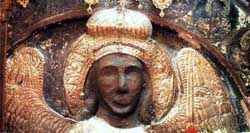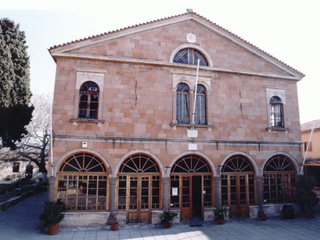 |
|
|
HCS Reader Creates Weblog for St. Taxiarchis of Lesvos |
|
 Miracle-working icon of Archangel Michael St. Taxiarchis Weblog of Manos |
|
|
HCS received email correspondence recently from a Mytilinean reader, Manos, who had created a weblog for St. Taxiarchis of Lesvos. He encouraged us to visit it and invited others to comment and offer feedback in the hope that more information would become readily available on the Internet about the history of this important Christian shrine and its patron saint whose miracle-working icon is highly regarded on the island. To the reader unfamiliar with Greek and its various systems of transliteration scattered throughout the literary world and the arena of computerized technology, "taxiarchis" translates as "archangel." In the case of St. Taxiarchis of Lesvos (singular grammatical form), the name appears to apply solely to Archangel Michael. Hence the often interchangeable translation of "Taxiarchis" with "Michael" in English, even though the correct Greek counterpart of "Michael" is "Michalis" [sometimes transliterated also as "Mihalis"]. Few Orthodox churches, however, are named after St. Taxiarchis, prefering to take the name "Taxiarchae," meaning "Archangels" (plural grammatical form). Taxiarchis is known as one of the patron saints of the Greek Aegean island Lesvos. Many children, both boys and girls, are named after this saint, taking the baptismal names of Taxiarchis (male) or Taxiarchoula (female), for example, or Michalis and Michaela (male and female, respectively). According to island guides, the Monastery of the Archangel (Taxiarchis) is located just outside of the village of Mandamados on the northeastern side of the island, among pine groves (36 km from the capital, Mytilene). Local history places the date of the first building of the church before 1700, with a complete reconstruction and enlargement in 1879 to a three-aisled basilica. Its interior is decorated in a special roccoco style with striking colors. The church is one of the most important pilgrimage destinations, best known for its embossed icon, a silver-wrought icon surrounding the head of Archangel Michael molded out of some unknown, dark substance. Tradition maintains that the head was fashioned by a monk from blood and clay after surviving a slaughter there by pirates. Some accounts date the massacre to about 1000 A.D. The monk was the only one to escape alive, having crawled up onto the roof of the monastery; when the Saracens tried to reach him, huge waves engulfed them. They soon became frightened and left him. The monk credited his salvation to a miracle of the Archangel and made the icon out of clay earth mixed with the blood of his slain brothers. The monastery also possesses many icons dating from the 16th century, precious sacerdotal vestments, including a gold-embroidered ecclesiastical stole dating to 1656, and the episcopal robe of martyred Ecumenical Patriarch Grigorios V, brought back by Bishop Porfirios Foliadis after Patriarch Grigorios was hanged by the Muslim Turks. Another icon of Archangel Michael, life-size, is situated just outside the church. Local tradition relates that during the Turkish invasion of Cyprus the icon would disappear for days at a time, returning periodically with dusty feet and shoes. Natives believed that the Archangel was guiding the Greek forces at that time. WEBLOG http://sainttaxiarchis.blogspot.com/
|
|
|
HCS readers may wish to view other articles and releases in our permanent, extensive archives at the URL http://www.helleniccomserve.com/contents.html., especially those of another area of the island Lesvos, a village called Vatoussa, in the northwestern section of this Aegean isle (http://www.helleniccomserve.com/archivevatoussa.html). |
|
|
|
|
|
2000 © Hellenic Communication Service, L.L.C. All Rights Reserved. http://www.HellenicComServe.com |
|

